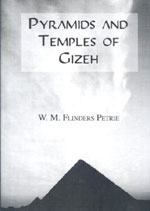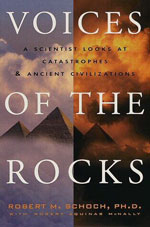
The Great Sphinx Dating Debate
–
page seven
text translation service for many worldwide languages
|
|
|
|
Comments by Robert M. Schoch on the Geological Analysis of Ian Lawton and Chris Ogilvie-Herald
found in chapter 7 (“The Age of the Sphinx”) of
“Giza: The Truth”.
[ by Robert M. Schoch. All rights reserved]
Dr. Robert M. Schoch continues the debate
…
“Origins of the Sphinx:
Celestial Guardian of Pre-Pharaonic Civilization”
by
Robert M. Schoch Ph.D.
and
Robert Bauval
Get This Book From:
Amazon.com
Amazon.co.uk
Today is
|
Books about the Great Sphinx & Pyramids
“Pyramid Quest: Secrets of the Great Pyramid and the Dawn of Civilization” by &
EU English Edition
“How is it that the Great Pyramid exercises such a gripping hold on the human psyche adding cryptic grace and framing myriad claims of New Age “pyramid power”? In “Pyramid Quest”, Robert M. Schoch and Robert Aquinas McNally use the rigorous intellectual analysis of scientific inquiry to investigate what we know about the Great Pyramid and develop a stunning hypothesis: this ancient monument is the strongest proof yet, that civilisation began thousands of years earlier than is generally thought, extending far back into a little-known time.
In tracing that story, we come to understand not only the Great Pyramid but also our own origins as civilised beings.”
“The Complete Pyramids: Solving the Ancient Mysteries” by
&
EU English Edition
“For centuries the pyramids have inspired passionate theories about their origins, purpose and method of construction. In this full work on the major pyramids of Ancient Egypt, the author surveys the history, building and use of the pyramids. He examines both the practicalities and logostics of their construction and their conceptual aspects – their cosmology and iconography and their intriguing texts.”
Mysteries Bookshoppe |
“Lawton and Ogilvie-Herald (page 326) state that “Schoch himself accepts the existence of New Kingdom repair blocks on the rump [‘rump’ is stressed by being placed in italics by L and O-H] of the monument, indicating that extensive weathering had taken place at the back since the orthodox carving date. So why could this rate of weathering not have applied all over?” This is a dishonest statement.
From my original 1992 KMT article to my 1999 book “Voices of the Rocks” I have pointed out the disagreement among Egyptologists (such as Lehner and Hawass) as to whether the earliest repairs to the Sphinx date to the Old Kingdom or New Kingdom. I have never definitively “accepted” any particular date for them, although I tend to suspect that Hawass is correct and they are indeed Old Kingdom.
Furthermore, I’ve made no statement nor judgement concerning the age of any repairs on the very western-most end of the core body of the Sphinx in the vicinity of where we ran our seismic line. Indeed, this area is currently covered at ground level with twentieth-century repair blocks that obscure any ancient repairs, and furthermore, evidence of New Kingdom repairs there (if they existed) would not invalidate the concept of an older Sphinx.
It is well known that the Sphinx has been refurbished and reworked many times over the centuries. New Kingdom repairs could easily have replaced Old Kingdom repairs, and of course not all repairs from all time periods cover or repair equal amounts of damage as Lawton and Ogilvie-Herald imply in the quote above. Lawton and Ogilvie-Herald go on to state (page 326) that “it is clear that the west wall [of the Sphinx enclosure] behind the rump [of the Sphinx] – – which according to Schoch’s theory must have been carved only c. 2500 BC – – shows exactly the same vertical and rounded profiles as the [presumably older] south wall.” (“shows . . . south wall”) is stressed by being placed in italics by L and O-H..
They therefore conclude that this obvious contradiction refutes my analysis. Actually it does nothing of the kind. Lawton and Ogilvie-Herald fail to mention that two “back walls” lie behind the rump of the Sphinx.
The higher “back wall”, which lies farther to the west, does indeed show rain weathering (“vertical and rounded profiles”) and dates back to pre- Old Kingdom times.
The seismic studies indicate that the lower “back wall”, set directly behind the rump of the Sphinx and lacking the “vertical and rounded profiles”, may have been excavated much later, possibly in Khafre’s time (circa 2500 B.C.), when I believe the rump of the Sphinx was reworked and possibly at that time carved down to the same level as the floor of the Sphinx enclosure on the other three sides of the sculpture. I discuss this issue explicitly in my 1992 KMT paper titled “Redating the Great Sphinx of Giza” – (see especially page 57).
These same authors argue against the two-stage construction of the so-called Valley and Sphinx temples, pointing out that some granite blocks have actually been worked into the Valley Temple and underlie an uppermost course of limestone blocks (page 331). Likewise, Old Kingdom pottery fragments have been found around and under detached limestone blocks of the Sphinx Temple (page 334).
This evidence they take to “prove” that the temples, and therefore the Sphinx itself, must date to Khafre’s time. However, it is perfectly conceivable, in fact to be expected, that Old Kingdom artifacts would be found around the temples and newer (that is, Old Kingdom) granite blocks would be incorporated into the actual temples during the rebuilding and refurbishing phase of Khafre’s time. Clearly, there was much activity on the Giza Plateau during the Fourth Dynasty, and we should expect to find the remains of that activity.”
Dr Robert M. Schoch’s response to criticisms by Ian Lawton & Chris Ogilvie-Herald in their book “Giza: The Truth” continues on:
|
“Voices of the Rocks: A Scientist Looks at Catastrophes and Ancient Civilizations” by
EU English Edition
“The great 19th-century battle between catastrophists and uniformitarians seemed to end with the notion of global cataclysms being dismissed as a back door to the supernatural.
But the catastrophist theory has gradually become more and more plausible, so that now, less than a hundred years later, it is widely believed that mass extinctions are linked to meteor strikes.” |
a selection of books about
Ancient Egyptian Mysteries
Prints & Posters of Ancient Egyptian Art |
Ancient Egyptian Mysteries Bookshoppe
please take a look at our Ancient Mysteries Bookshoppe for a wide selection of books
that challenge orthodox views of prehistory on every continent
|
|
2019 Skywatching Calendar |
News & New Discoveries |
Marine Archaeology News 2019 |
Astro-Archaeology News 2019
The Morien Institute









